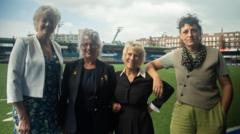What Outrageous Idea Unites Four Friends as Scrum Queens?

In 1991, four pioneering women—Mary Forsyth, Deborah Griffin, Sue Dorrington, and Alice Cooper—faced significant challenges to establish the first Women's Rugby World Cup in Cardiff, Wales. Despite initial rejection and limited resources, their determination led to a groundbreaking event that laid the foundation for women's rugby globally. Today, the legacy of their efforts resonates as the sport continues to grow, with record participation and viewership.
Last updated: 19 August 2023 (BST)
Key Takeaways
- The first Women's Rugby World Cup took place in Cardiff in 1991, initiated by four determined women.
- Despite financial struggles and lack of support, the tournament attracted 12 international teams.
- The event marked a significant milestone, establishing women's rugby on the global stage.
- 34 years later, the Richmond four reunited to celebrate their achievements and the sport's evolution.
- The legacy of their work continues to inspire a new generation of female rugby players.
The Origin of a Vision
In the late 1980s, women's rugby was largely overlooked, with scant opportunities for female athletes. Among those determined to change that were Forsyth, Griffin, Dorrington, and Cooper, who met while playing for Richmond Rugby Football Club. They shared a vision: to create a global tournament that would showcase women's rugby skills and foster international competition.
However, realising this vision was no easy feat. The International Rugby Board (IRB) was dismissive of their plans. Dorrington recalls a pivotal meeting in a large boardroom, where their ambitious proposal was met with indifference: “They wanted nothing to do with us.” Undeterred, the women pressed on, knowing that they would have to shoulder all the responsibilities themselves.
Breaking Down Challenges
With no corporate sponsors and minimal support, the Richmond four divided the tasks among themselves. They managed logistics, marketing, and finances while juggling full-time jobs. Griffin remembers the late-night meetings, “We used to meet up at eight o'clock and divvy up the tasks that had to be done.”
Their first task was to identify teams that could compete at an international level. Countries like the USA, France, and New Zealand had existing teams, but many others were in a similar predicament, struggling for recognition. As Italy’s Morri noted, “We were absolutely an undercover movement.”
Finding a Home for the Tournament
After securing 12 teams, the next challenge was finding a suitable venue. The women desired a location with a strong rugby culture. Wales emerged as the ideal host. Dorrington said, “What we knew was how strongly rugby was supported in Wales.” The Cardiff Arms Park was offered as the venue for the final, which became a pivotal moment for the tournament.
Other matches were set to be played at grounds across Wales, including those of Glamorgan Wanderers and Swansea. The community embraced the tournament, providing vital local support. “The Welsh couldn’t have been more welcoming,” Cooper remarked.
Financial Struggles and Team Spirit
Initially, the Richmond four promised the teams that their accommodation and meals would be covered. However, as costs spiralled to £35,000, it became clear they were in over their heads. Dorrington remembers the moment they had to confront the teams, “We did not think the tournament could go ahead.” To their surprise, the teams rallied together to cover costs, demonstrating the strong spirit of camaraderie.
Yet, not all teams faced the same challenges. The Russian team struggled financially due to restrictions on currency, forcing them to be resourceful. Cooper recounted, “They used to come down and do a sweep at breakfast and live on cornflakes for lunch.” The Cardiff community, however, stepped up, providing food and essentials to support the teams.
The Build-Up to the Tournament
As the tournament drew nearer, media attention began to build. However, the coverage often leaned towards the sensational, with some critics dismissing women’s rugby as a “novelty.” Cooper reflected on the mixed press: “There was quite a lot of detractors going ‘that’ll be a load of rubbish.’” Despite this, the Richmond four remained focused on their goal.
As the opening day approached, the women were overwhelmed, juggling personal responsibilities alongside their roles in the organisation. Griffin and Forsyth had recently given birth, while Dorrington was actively playing for England. The pressure was immense, with Cooper stating, “By the final, we were absolutely hanging.”
A Historic Event
The first Women’s Rugby World Cup kicked off on 4 April 1991, bringing together teams from around the globe. The opening ceremony at Cardiff Arms Park was a vibrant celebration, as players from different nations bonded over their shared love for the sport. Former Wales captain Liza Burgess recalled the excitement of seeing teams in their tracksuits, showcasing their national pride.
Italy's Morri described the moment as "super emotional," feeling a sense of belonging and purpose. “We were feeling like pioneers,” she said. The tournament featured 21 matches over eight days, culminating in a final where the USA triumphed over England, securing the title with a score of 19-6 in front of 3,000 fans.
The Aftermath and Legacy
Although the tournament was deemed a success, it came with a financial deficit of £6,756, partly due to the concurrent men's World Cup. The Richmond four faced an uncertain future, with whispers about remortgaging their homes. Thankfully, anonymous pledges and support from the Rugby Football Union helped settle the debts.
However, the emotional toll was profound. Dorrington faced job loss, and Griffin dealt with personal challenges following her daughter’s birth. “It was hard. It came at a great personal cost,” she reflected. The women had poured their hearts into the tournament, and the aftermath was a time for healing.
A Reunion and Reflection
Fast forward 34 years, the Richmond four reunited at Cardiff Arms Park to commemorate their achievements. They presented plaques to the host venues that had supported their historic event. “It has had an immense impact on the game,” Griffin stated, reflecting on the tournament's legacy.
Dorrington noted their naivety in not realising the significance of their actions, stating, “We did it because it needed to be done.” The impact of their pioneering work has been long-lasting, providing a foundation for the growth of women's rugby worldwide.
The Future of Women's Rugby
As we look ahead to the latest iteration of the Women's Rugby World Cup, it is clear the sport has grown exponentially. With more teams, increased media coverage, and a growing fan base, the legacy of the Richmond four is alive and well. Their vision has transformed into a global movement, inspiring countless women to take up the sport.
As record crowds prepare to witness the latest World Cup matches, it is essential to remember the sacrifices made by those who came before. The journey of women's rugby continues to evolve, and with it, the opportunities for female athletes around the world.
FAQs
What was the significance of the 1991 Women's Rugby World Cup?
The 1991 Women's Rugby World Cup was the first international tournament for women's rugby, marking a pivotal moment in the sport's history and promoting the visibility of female athletes on a global scale.
Who were the main figures behind the tournament?
Mary Forsyth, Deborah Griffin, Sue Dorrington, and Alice Cooper were the key figures in organising the 1991 Women's Rugby World Cup, overcoming numerous obstacles to bring their vision to life.
How did the tournament impact women's rugby globally?
The tournament established a platform for women's rugby, leading to increased participation and investment in the sport, further encouraging the development of women's leagues and competitions worldwide.
What challenges did the organisers face?
The organisers faced financial difficulties, lack of support from rugby governing bodies, and logistical challenges, but their determination and teamwork ultimately made the tournament a success.
What is the legacy of the Richmond four?
The Richmond four's legacy is evident in the continued growth and recognition of women's rugby, inspiring future generations of female athletes and ensuring that their contributions are remembered.
As we celebrate the achievements of those who paved the way for women in rugby, it’s important to reflect on how far the sport has come and the challenges that still lie ahead. The journey of women's rugby is just beginning, and its future looks brighter than ever. #WomensRugby #Trailblazers #RugbyHistory
Published: 2025-08-21 03:30:57 | Category: wales



